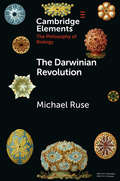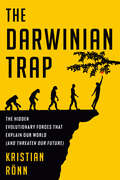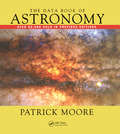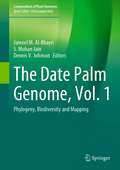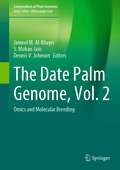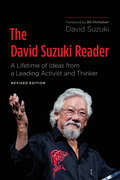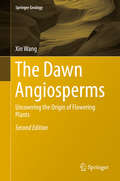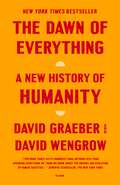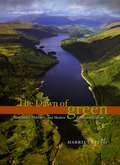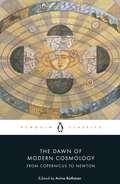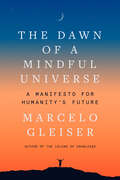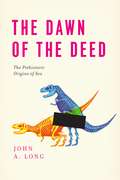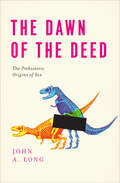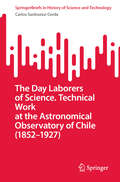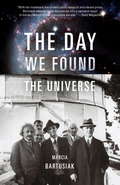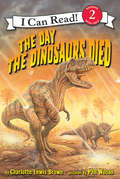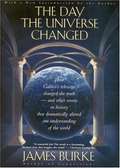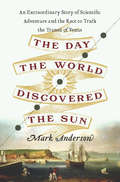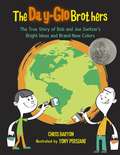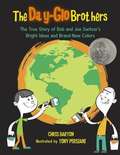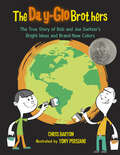- Table View
- List View
The Darwinian Revolution (Elements in the Philosophy of Biology)
by Michael RuseWhat is the Darwinian revolution and why is it important for philosophers? These are the questions tackled in this Element. In four sections, the topics covered are the story of the revolution, the question of whether it really was a revolution, the nature of the revolution, and the implications for philosophy, both epistemology and ethics.
The Darwinian Tradition in Context: Research Programs In Evolutionary Biology
by Richard G. DelisleIt is the main goal of this volume to put in context the Darwinian tradition by raising questions such as: How should it be defined? Did it interacted with other research programs? Where there any research programs whose developments were largely conducted independently of the Darwinian tradition? Contributors to this volume explicitly reflect upon the nature of the relationship between the Darwinian tradition and other research programs running in parallel. In the wake of the Synthetic Theory of Evolution which was constituted in the 1930s, 1940s, and 1950s, historians and philosophers of biology have devoted considerable attention to the Darwinian tradition, i. e. , linking Charles Darwin to mid-Twentieth-Century developments in evolutionary biology. Since then, more recent developments in evolutionary biology challenged, in part only or entirely, the heritage of the Darwinian tradition. Expectedly, this was followed by a historiographical "recalibration" by historians and philosophers towards other research programs and traditions part of evolutionary biology since Darwin's time. In order to acknowledge this shift, papers have been arranged along two main threads: Part I: The view that sees Darwinism as either originally pluralistic or acquiring such a pluralism through modifications and borrowings over time. Part II: The view blurring the boundaries between non-darwinian and darwinian traditions, either by holding that Darwinism itself was never quite as darwinian as previously thought, or that non-darwinian traditions took on board some darwinian components, when not fertilizing Darwinism directly. Between a Darwinism reaching out to other research programs and non-darwinian programs reaching out to Darwinism, the least that can be said is that this criss-crossing of intellectual threads blurs the historiographical field. This volume aims to open new thinking avenues about the development of evolutionary biology.
The Darwinian Trap: The Hidden Evolutionary Forces That Explain Our World (and Threaten Our Future)
by Kristian RönnA provocative exploration of how humans are wired to seek short-term success at the expense of long-term survival—an evolutionary &“glitch&” that explains everything from toxic workplaces to climate change&“Essential reading . . . a lively, ultimately hopeful examination of how incentivizing the wrong values and actions has led to some of our most intractable problems.&”—Eric Ries, New York Times bestselling author of The Lean StartupWhen people talk about today&’s biggest challenges—pollution, misinformation, artificial intelligence, inept CEOs, and politicians—they tend to frame the conversation around &“bad people&” doing &“bad things.&” But is there more to the story?Humans, it turns out, are intrinsically wired to seek short-term success at the expense of long-term prosperity. Kristian Rönn, an entrepreneur formerly affiliated with the University of Oxford&’s Future of Humanity Institute, calls these deeply rooted impulses &“Darwinian demons.&” These forces, a by-product of natural selection, can lead us to act in shortsighted ways that harm others—and even imperil our survival as a species. If this evolutionary glitch is left unchecked, the consequences will grow in magnitude as the power of technology accelerates.In this eye-opening work, Rönn shows that we must learn to cooperate in new ways if we are to escape these evolutionary traps in our daily lives and solve our biggest existential threats. Evolution may be to blame for the trap—but humans need not fall for it. Our salvation, he writes, will involve the creation of new systems that understand, track, and manage what humankind values most.Bold, brilliant, and ultimately optimistic, The Darwinian Trap gives readers a powerful new lens on our world and its problems, and invites us to rethink our priorities for the sake of generations to come.
The Data Book of Astronomy
by Patrick MooreFilled with data about the Earth, Moon, the planets, the stars, our Galaxy, and the myriad galaxies in deep space, this invaluable resource reveals the latest scientific discoveries about black holes, quasars, and the origins of the Universe. It includes maps supported by detailed tables of the names, positions, magnitudes, and spectra of the main stars in each constellation along with key data on galaxies, nebulae, and clusters. MNASSA wrote, "This book fills a niche � with detailed astronomical data and concise explanations, all at an accessible level � it is an excellent resource, and probably will be the first book I shall reach for.
The Date Palm Genome, Vol. 1: Phylogeny, Biodiversity and Mapping (Compendium of Plant Genomes)
by S. Mohan Jain Jameel M. Al-Khayri Dennis V. JohnsonThis book is the first volume of a comprehensive assemblage of contemporary knowledge relevant to genomics and other omics in date palm. Volume 1 consists of 11 chapters arranged in 3 parts grouped according to subject. Part I, Biology and Phylogeny, focuses on date palm biology, evolution and origin. Part II, Biodiversity and Molecular Identification, covers conformity of in vitro derived plants, molecular markers, barcoding, pollinizer genetics and gender determination. Part III, Genome Mapping and Bioinformatics, addresses genome mapping of nuclear, chloroplast and mitochondrial DNA, in addition to a chapter on progress made in date palm bioinformatics. This volume represents the efforts of 30 international scientists from 10 countries and contains 78 figures and 30 tables to illustrate presented concepts. Volume 2 is published under the title: Omics and Molecular Breeding.
The Date Palm Genome, Vol. 2: Omics and Molecular Breeding (Compendium of Plant Genomes)
by S. Mohan Jain Jameel M. Al-Khayri Dennis V. JohnsonThis book is the first comprehensive assemblage of contemporary knowledge relevant to genomics and other omics in date palm. Volume 2 consists of 11 chapters. Part I, Nutritional and Pharmaceuticals Properties, covers the utilization of date palm as an ingredient of various food products, a source of bioactive compounds and the production of nanomaterials. Part II, Omics Technologies, addresses omics resources, proteomics and metabolomics. Part III, Molecular Breeding and Genome Modification, focuses on genetic improvement technologies based on mutagenesis, quantitative traits loci and genome editing. Part IV, Genomics of Abiotic and Biotic Stress, covers metagenomics of beneficial microbes to enhance tolerance to abiotic stress and the various genomics advances as they apply to insect control. This volume represents the efforts of 34 international scientists from 12 countries and contains 65 figures and 19 tables to illustrate presented concepts. Volume 1 is published under the title: Phylogeny, Biodiversity and Mapping.
The David Suzuki Reader
by Bill Mckibben David SuzukiDavid Suzuki's collected writings on science, nature, technology, economics, politics, and the connectedness of all things.The David Suzuki Reader brings together for the first time the scientific and philosophical thought of North America's leading environmentalist.Drawing from Suzuki's published and unpublished writings, this collection reveals the underlying themes that have informed his work for over four decades. In these incisive and provocative essays, Suzuki explores the limits of knowledge and the connectedness of all things; looks unflinchingly at the destructive forces of globalization, political shortsightedness, and greed; cautions against blind faith in science, technology, politics, and economics; and provides inspiring examples of how and where to make those changes that will matter to all of us and to future generations. He also offers a vision of hope based on our love of children and nature.In this time of global unrest and uncertainty, Suzuki provides an important reminder of how we are all connected and of what really matters. Written with clarity, passion, and wisdom, this book is essential reading for anyone who is an admirer of David Suzuki, who wants to understand what science can and can't do, or who wants to make a difference.
The David Suzuki Reader
by Bill Mckibben David SuzukiIn this revised and expanded edition of his collected writings, David Suzuki continues to explore the themes that have informed his work for more than four decades - the interconnectedness of all things, our misguided elevation of economics above all else, the urgent need to deal with climate change - but with an increased emphasis on solutions to the myriad problems we face, his inspiring vision for the future, and the legacy he hopes to leave behind. There is also more emphasis on the personal, as he recounts episodes from his childhood and early adulthood and speaks eloquently about old age, death, and the abiding role of nature and family in his life. Written with clarity, passion, and wisdom, this book is essential for anyone who is an admirer of David Suzuki, who wants to understand what science can and can't do, or who wants to make a difference.
The David Suzuki Reader
by David SuzukiDavid Suzuki’s collected writings on science, nature, technology, economics, politics, and the connectedness of all things. The David Suzuki Reader brings together for the first time the scientific and philosophical thought of North America’s leading environmentalist. Drawing from Suzuki’s published and unpublished writings, this collection reveals the underlying themes that have informed his work for over four decades. In these incisive and provocative essays, Suzuki explores the limits of knowledge and the connectedness of all things; looks unflinchingly at the destructive forces of globalization, political shortsightedness, and greed; cautions against blind faith in science, technology, politics, and economics; and provides inspiring examples of how and where to make those changes that will matter to all of us and to future generations. He also offers a vision of hope based on our love of children and nature. In this time of global unrest and uncertainty, Suzuki provides an important reminder of how we are all connected and of what really matters. Written with clarity, passion, and wisdom, this book is essential reading for anyone who is an admirer of David Suzuki, who wants to understand what science can and can’t do, or who wants to make a difference.
The Dawn Angiosperms
by Xin WangAngiosperms are the most diversi ed plant group in the world, being represented by ca 300,000 species in about 400 families. Like all of Life, including ourselves, they have had their own history and gone through many evolutionary stages before they arrived at their current forms. The origin of Angiospermae ( owering plants) has been the subject of much dispute because this is a key event in the history of life, and has a far-reaching in uence on our understanding of relationships among seed plants as a whole as well as within the angiosperms. Until recently most of palae- otanists recognized angiosperms only from the Cretaceous and younger strata. This contradicts the results of molecular analyses. I have been working on Mesozoic fossil plants for the past two decades, during which time I have studied a number of fossil plants. Some of these fossil plants have been published as Jurassic angiosperms, and, unsurprisingly, many questions and doubts have been raised about them. These questions need to be addressed se- ously and journal papers do not provide suf cient space to compare and relate these early angiosperms. In this book these pioneer angiosperms are documented in detail, sometimes with new specimens not studied before. Also, I propose a de nition of angiosperms that could be adopted in palaeobotany. My aim is to improve clarity and objectivity of judgment about what constitutes a fossil angiosperm.
The Dawn of Everything: A New History of Humanity
by David Graeber David WengrowRenowned activist and public intellectual David Graeber teams up with professor of comparative archaeology David Wengrow to deliver a trailblazing account of human history, challenging our most fundamental assumptions about social evolution--from the development of agriculture and cities to the emergence of "the state," political violence, and social inequality--and revealing new possibilities for human emancipation. <p><p>For generations, our remote ancestors have been cast as primitive and childlike--either free and equal innocents, or thuggish and warlike. Civilization, we are told, could only be achieved by sacrificing those original freedoms, or alternatively, by taming our baser instincts. Graeber and Wengrow show how such theories first emerged in the eighteenth century as a conservative reaction to powerful critiques of European society posed by Indigenous observers and intellectuals. Revisiting this encounter has startling implications for how we make sense of human history today, including the origins of farming, property, cities, democracy, slavery, and civilization itself. <p><p> Drawing on path-breaking research in archaeology and anthropology, the authors show how history becomes a far more interesting place once we learn to throw off our conceptual shackles and perceive what's really there. If humans did not spend 95% of their evolutionary past in tiny bands of hunter-gatherers, what were they doing all that time? If agriculture, and cities, did not mean a plunge into hierarchy and domination, then what kinds of social and economic organization did they lead to? What was really happening during the periods that we usually describe as the emergence of "the state"? The answers are often unexpected, and suggest that the course of human history may be less set in stone, and more full of playful, hopeful possibilities, than we tend to assume. <p><p> The Dawn of Everything fundamentally transforms our understanding of the human past and offers a path toward imagining new forms of freedom, new ways of organizing society. This is a monumental book of formidable intellectual range, animated by curiosity, moral vision, and a faith in the power of direct action. <p> <b>New York Times Bestseller</b>
The Dawn of Green: Manchester, Thirlmere, and Modern Environmentalism
by Harriet RitvoLocated in the heart of England’s Lake District, the placid waters of Thirlmere seem to be the embodiment of pastoral beauty. But under their calm surface lurks the legacy of a nineteenth-century conflict that pitted industrial progress against natural conservation—and helped launch the environmental movement as we know it. Purchased by the city of Manchester in the 1870s, Thirlmere was dammed and converted into a reservoir, its water piped one hundred miles south to the burgeoning industrial city and its workforce. This feat of civil engineering—and of natural resource diversion—inspired one of the first environmental struggles of modern times. The Dawn of Green re-creates the battle for Thirlmere and the clashes between conservationists who wished to preserve the lake and developers eager to supply the needs of a growing urban population. Bringing to vivid life the colorful and strong-minded characters who populated both sides of the debate, noted historian Harriet Ritvo revisits notions of the natural promulgated by romantic poets, recreationists, resource managers, and industrial developers to establish Thirlmere as the template for subsequent—and continuing—environmental struggles.
The Dawn of Modern Cosmology: From Copernicus to Newton
by René Descartes Galileo Galilei Isaac Newton Nicolaus Copernicus Johannes KeplerNew to Penguin Classics, the astonishing story of the Copernican Revolution, told through the words of the ground-breaking scientists who brought it aboutIn the late fifteenth century, it was believed that the earth stood motionless at the centre of a small, ordered cosmos. Just over two centuries later, everything had changed. Not only was the sun the centre of creation, but the entire practice of science had been revolutionised. This is the story of that astonishing transformation, told through the words of the astronomers and mathematicians at its heart. Bringing together excerpts from the works and letters of Copernicus, Galileo, Kepler, Descartes, Newton and others for the first time, The Dawn of Modern Cosmology is the definitive record of one of the great turning points in human history.Edited with Translations, Notes and an Introduction by Aviva Rothman
The Dawn of a Mindful Universe: A Manifesto for Humanity's Future
by Marcelo GleiserAn award-winning astronomer and physicist’s spellbinding and urgent call for a new Enlightenment and the recognition of the preciousness of life using reason and curiosity—the foundations of science—to study, nurture, and ultimately preserve humanity as we face the existential crisis of climate change. Since Copernicus, humanity has increasingly seen itself as adrift, an insignificant speck within a large, cold universe. Brazilian physicist, astronomer, and winner of the 2019 Templeton Prize Marcelo Gleiser argues that it is because we have lost the spark of the Enlightenment that has guided human development over the past several centuries. While some scientific efforts have been made to overcome this increasingly bleak perspective—the ongoing search for life on other planets, the recent idea of the multiverse—they have not been enough to overcome the core problem: we’ve lost our moral mission and compassionate focus in our scientific endeavors.Gleiser argues that we’re using the wrong paradigm to relate to the universe and our position in it. In this deeply researched and beautifully rendered book, he calls for us to embrace a new life-centric perspective, one which recognizes just how rare and precious life is and why it should be our mission to preserve and nurture it. The Dawn of a Mindful Universe addresses the current environmental and scientific impasses and how the scientific community can find solutions to them.Gleiser’s paradigm rethinks the ideals of the Enlightenment, and proposes a new direction for humanity, one driven by human reason and curiosity whose purpose is to save civilization itself. Within this model, we can once again see ourselves as the center of the universe—the place where life becomes conscious—and regain a clear moral compass which can be used to guide both science and the politics around it.
The Dawn of the Deed: The Prehistoric Origins of Sex
by John A. LongWe all know about the birds and the bees, but what about the ancient placoderm fishes and the dinosaurs? The history of sex is as old as life itself--and as complicated and mysterious. And despite centuries of study there is always more to know. In 2008, paleontologist John A. Long and a team of researchers revealed their discovery of a placoderm fish fossil, known as "the mother fish," which at 380 million years old revealed the oldest vertebrate embryo--the earliest known example of internal fertilization. As Long explains, this find led to the reexamination of countless fish fossils and the discovery of previously undetected embryos. As a result, placoderms are now considered to be the first species to have had intimate sexual reproduction or sex as we know it--sort of. Inspired by this incredible find, Long began a quest to uncover the paleontological and evolutionary history of copulation and insemination. In The Dawn of the Deed, he takes readers on an entertaining and lively tour through the sex lives of ancient fish and exposes the unusual mating habits of arthropods, tortoises, and even a well-endowed (16. 5 inches!) Argentine Duck. Long discusses these significant discoveries alongside what we know about reproductive biology and evolutionary theory, using the fossil record to provide a provocative account of prehistoric sex. The Dawn of the Deed also explores fascinating revelations about animal reproduction, from homosexual penguins to monogamous seahorses to the difficulties of dinosaur romance and how sexual organs in ancient shark-like fishes actually relate to our own sexual anatomy. The Dawn of the Deed is Long's own story of what it's like to be a part of a discovery that rewrites evolutionary history as well as an absolutely rollicking guide to sex throughout the ages in the animal kingdom. It's natural history with a naughty wink.
The Dawn of the Deed: The Prehistoric Origins of Sex
by John A. Long&“[A] deliciously written account of the evolution of sex, in all of its bizarre manifestations&” by a noted paleontologist—"Read, blush, and enjoy!&” (Jared Diamond, author of Guns, Germs, and Steel). We all know about the birds and the bees, but what about the ancient placoderm fishes and the dinosaurs? In 2008, paleontologist John A. Long and a team of researchers announced their discovery of a 380-million-year-old placoderm fish fossil, known as &“the mother fish,&” which revealed the earliest known example of internal fertilization. As a result, placoderms are now considered to be the first species to have had intimate sexual reproduction, or sex as we know it—sort of. Inspired by this incredible find, Long began a quest to uncover the evolutionary history of copulation and insemination. In The Dawn of the Deed, he takes readers on a lively tour through the sex lives of ancient fish and the unusual mating habits of arthropods, tortoises, and even a well-endowed Argentine Duck. Long discusses these discoveries alongside what we know about reproductive biology and evolutionary theory, using the fossil record to provide a provocative account of prehistoric sex. The Dawn of the Deed also explores fascinating revelations about animal reproduction, from homosexual penguins to monogamous seahorses to the difficulties of dinosaur romance.
The Day Laborers of Science. Technical Work at the Astronomical Observatory of Chile (SpringerBriefs in History of Science and Technology)
by Carlos Sanhueza-CerdaThis book fills a significant gap in the historiography of science by examining the overlooked contributions of non-astronomical personnel in the early National Astronomical Observatory of Chile. Drawing upon David Edgerton's critique of the bias towards academic scientists in historical narratives, this research delves into the roles of other scientists, technicians, collaborators, and other support staff in shaping scientific endeavors. The book analyzes archival documents and reveals the essential yet often unacknowledged labor involved in routine scientific tasks. By challenging the hierarchical structure of observatory organizations and spotlighting the significance of routine work, the book redefines the production of scientific knowledge beyond the conventional focus on eminent scientists. Emphasizing the importance of failures, conflicts, and controversies, this book unveils the hidden narratives of everyday scientific labor, offering a more comprehensive understanding of the history of astronomy in Chile.
The Day We Found the Universe
by Marcia BartusiakBartusiak teaches at MIT, is the award-winning author of several books, and has contributed to numerous publications including National Geographic, Smithsonian, The New York Times, and The Washington Post. In her latest text she presents an account of the discovery of the modern universe in the early-20th century. The story details the contributions made by not only Edwin Hubble but also the many talented and scientists working behind the scenes, including Henrietta Leavitt, Vesto Slipher, Georges Lemâitre, Milton Humason, and Harlow Shapley. Illustrated with b&w photographs. Academic but accessible to general readers. Annotation ©2009 Book News, Inc. , Portland, OR (booknews. com)
The Day the Dinosaurs Died (I Can Read Level 2)
by Charlotte Lewis BrownPresenting cutting-edge science to the youngest readers, The Day the Dinosaurs Died is a mesmerizing account of the end of the dinosaurs.The dinosaurs were the biggest, most powerful animals that ever walked the earth. Now they are all gone, extinct. Bold illustrations and a dramatic text re-create the devastation sixty-five million years ago when a giant asteroid slammed into Earth, triggering global disasters and leading to massive worldwide extinctions.The Day the Dinosaurs Died is a Level Two I Can Read, geared for kids who read on their own but still need a little help. Whether shared at home or in a classroom, the engaging stories, longer sentences, and language play of Level Two books are proven to help kids take their next steps toward reading success.
The Day the Screens Went Blank: The Brand-new Comedy Adventure From The Author Of The Day The Screens Went Blank
by Danny WallaceA hilarious middle-grade road-trip adventure from bestselling author, comedian, and presenter Danny Wallace, with illustrations throughout from Gemma Correll. Perfect for fans of Liz Pichon and David Baddiel! When ten-year-old Stella wakes up to discover a world full of BLANK screens, her family, town, and in fact the whole world seems to have been thrown into chaos. And what about poor Grandma who is stranded at the other end of the country? Cue a rollicking madcap road trip, full of driving disasters and family fallouts, as they set off on a rescue mission. And along the way Stella and her family discover that being away from screens might not be the Worst Thing Ever, and even though they might not be able to rely on technology anymore, they can rely on each other instead.Also by Danny Wallace:Hamish and WorldStoppers Hamish and the Neverpeople Hamish and the Gravity Burp Hamish and the Baby Boom Hamish and the Monster Patrol Hamish and the Terrible Terrible Christmas
The Day the Universe Changed
by James Lee BurkeIn The Day the Universe Changed, James Burke examines eight periods in history when our view of the world shifted dramatically: in the eleventh century, when extraordinary discoveries were made by Spanish crusaders; in fourteenth-century Florence, where perspective in painting emerged; in the fifteenth century, when the advent of the printing press shook the foundations of an oral society; in the sixteenth century, when gunnery developments triggered the birth of modern science; in the early eighteenth century, when hot English summers brought on the Industrial Revolution; in the battlefield surgery stations of the French revolutionary armies, where people first became statistics; in the nineteenth century, when the discovery of dinosaur fossils led to the theory of evolution; and in the 1820s, when electrical experiments heralded the end of scientific certainty. Based on the popular television documentary series, The Day the Universe Changed is a bestselling history that challenges the reader to decide whether there is absolute knowledge to discover - or whether the universe is "ultimately what we say it is."
The Day the World Discovered the Sun
by Mark AndersonOn June 3, 1769, the planet Venus briefly passed across the face of the sun in a cosmic alignment that occurs twice per century. Anticipation of the rare celestial event sparked a worldwide competition among aspiring global superpowers, each sending their own scientific expeditions to far-flung destinations to time the planet’s trek. These pioneers used the "Venus Transit” to discover the physical dimensions of the solar system and refine the methods of discovering longitude at sea. In this fast-paced narrative, Mark Anderson reveals the stories of three Venus Transit voyages--to the heart of the Arctic, the New World, and the Pacific—that risked every mortal peril of a candlelit age. With time running out, each expedition struggles to reach its destination-a quest that races to an unforgettable climax on a momentous summer day when the universe suddenly became much larger than anyone had dared to imagine. The Day the World Discovered the Suntells an epic story of the enduring human desire to understand our place in the universe.
The Day-Glo Brothers: The True Story of Bob and Joe Switzer's Bright Ideas And Brand-new Colors (Into Reading, Trade Book #7)
by Chris Barton Tony PersianiNIMAC-sourced textbook <P><P>A discovery that made the world a brighter place! Joe and Bob Switzer were very different brothers. Bob was a studious planner who wanted to grow up to be a doctor. Joe dreamed of making his fortune in show business and loved magic tricks and problem-solving. <P><P>When an accident left Bob recovering in a darkened basement, the brothers began experimenting with ultraviolet light and fluorescent paints. Together they invented a whole new kind of color, one that glows with an extra-special intensity—Day-Glo.
The Day-Glo Brothers: The True Story of Bob and Joe Switzer's Bright Ideas and Brand-New Colors
by Chris BartonAn illuminating tale.<P><P> Why did you pick up this book?<P> Did it have something to do with the eye-popping colors on the cover?<P> You can thank Bob and Joe Switzer for those shocking greens, blazing oranges, and screaming yellows.<P> The brothers invented a whole new kind of color--one that glowed with an extra-special intensity. It took them years of experimenting, but their efforts paid off brilliantly.<P> Day-Glo colors helped win a war, save people's lives, and brighten everyday life--including this book!<P> Winner of the Sibert Honor
The Day-Glo Brothers: The True Story of Bob and Joe Switzer's Bright Ideas and Brand-New Colors
by Chris BartonA discovery that made the world a brighter place!Joe and Bob Switzer were very different brothers. Bob was a studious planner who wanted to grow up to be a doctor. Joe dreamed of making his fortune in show business and loved magic tricks and problem-solving. When an accident left Bob recovering in a darkened basement, the brothers began experimenting with ultraviolet light and fluorescent paints. Together they invented a whole new kind of color, one that glows with an extra-special intensity—Day-Glo.This cover reproduction is not printed with Day-Glo colors. The actual book, however, is printed using three Day-Glo colors: Saturn Yellow, Fire Orange, and Signal Green.
